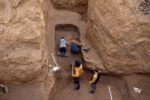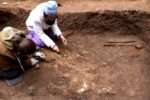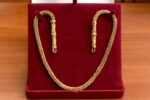 Archaeologists have discovered an unusual resident in a Scythian burial mound in Rostov, southwestern Russia: a warrior from the Southern Urals. He was buried with an Scythian leader in the 4th century B.C., but the central burial was looted in antiquity leaving his bodyguard as the stand-out discovery.
Archaeologists have discovered an unusual resident in a Scythian burial mound in Rostov, southwestern Russia: a warrior from the Southern Urals. He was buried with an Scythian leader in the 4th century B.C., but the central burial was looted in antiquity leaving his bodyguard as the stand-out discovery.
The presence of the burial mound was first noted by archaeologists in 1976, but thorough professional excavations only began last September. An initial geophysical survey revealed that the mound contained a profusion of burials from different periods, and the subsequent excavation confirmed the range of dates, with the oldest artifact a stone axe from the Cimmerian period (8th-7th centuries B.C.).
 When the archaeologists reached the central burial 18 feet below the surface, all that was left of the Scythian ruler buried there was one skull. Of his grave goods, only five amphorae remained. The plunderers missed his attendant, however. The man was exceptionally tall, about 6’6″, and his skeletal remains indicate he was ritually killed to accompany his master in death.
When the archaeologists reached the central burial 18 feet below the surface, all that was left of the Scythian ruler buried there was one skull. Of his grave goods, only five amphorae remained. The plunderers missed his attendant, however. The man was exceptionally tall, about 6’6″, and his skeletal remains indicate he was ritually killed to accompany his master in death.
 His burial was richly furnished. He wore a very fine gold chain, and a full complement of weapons were by his side: a slingshot, a quiver, arrows, two spears, darts and iron sword with a hilt wrapped in gold foil. There is also a Greek lekythos vessel for incense or oil. Above him are the remains of a horse.
His burial was richly furnished. He wore a very fine gold chain, and a full complement of weapons were by his side: a slingshot, a quiver, arrows, two spears, darts and iron sword with a hilt wrapped in gold foil. There is also a Greek lekythos vessel for incense or oil. Above him are the remains of a horse.
It was the sword that provided the first clue to the man’s origin. Even though the blade was heavily corroded, archaeologists identified it as a type  used by the nomadic peoples of the Southern Urals at that time. Other objects confirmed his origin. The horse wore a deer-shaped nosepiece typical of the Urals or Altai mountains. A large bronze cauldron with horizontal handles is also typical of the Southern Urals. Scythian cauldrons had vertical handles.
used by the nomadic peoples of the Southern Urals at that time. Other objects confirmed his origin. The horse wore a deer-shaped nosepiece typical of the Urals or Altai mountains. A large bronze cauldron with horizontal handles is also typical of the Southern Urals. Scythian cauldrons had vertical handles.
Sergey Lukyashko, Ph. D, professor from the Don State Technical University, commented on the find: “As we can see, this burial is not
typical. Here we see many eastern artefacts, but also objects from the Greek world. We have a hypothesis, that these people have come from the east, however, we cannot say for certain judging by just this one burial.”
The artefacts and the warlord’s remains will be sent for anthropological research to the Institute of Archaeology (Russian Academy of Sciences), where the scientists will determine the man’s age and place of birth.
I would imagine 6’6″ must have been quite gigantic in that era.
The “Southern Urals” –more or less– seem to connect to the northern Caspian Sea, wile the river Don flows from Central Russia into the Sea of Azov in Southern Russia, i.e. the Black Sea. Likewise, there is a river Kagalnik (Кагальник, i.e. not “Kagalchik”) that also flows to the Sea of Azov. Thus, what is the “Kagalchik” all about?
If the tumulus is indeed located between the Don and the Kagalnik river –Scythians are not unheard of in the area, and the Sea of Azov connected the Greek world to the Scythian one– the “Southern Urals” would be to the East of it. Herodotus knew that the steppe is vast and that Skythians intermingled with what he refers to as “Mountain Persians”.
—–
“During the first millennium BCE, nomadic people spread over the Eurasian Steppe from the Altai Mountains over the northern Black Sea area as far as the Carpathian Basin […] Greek and Persian historians of the 1st millennium BCE chronicle the existence of the Massagetae and Sauromatians, and later, the Sarmatians and Sacae: cultures possessing artefacts similar to those found in classical Scythian monuments, such as weapons, horse harnesses and a distinctive ‘Animal Style’ artistic tradition. Accordingly, these groups are often assigned to the Scythian culture”
—–
youtube.com/watch?v=3encA6KYQUI (Music: – Ойно, ойно, Алтай; играй) :boogie:
That “bronze cauldron” definitely raises questions on the consumed beverage –tea?, magic potion?, beer? 😮
The Amyrgians were called (+)”Saka” haumavarga ((*)”Haoma-drinking Scythians”) in Old Persian, which is a reinterpretation of the personal names Amorges and (H)omarges. The Greek form of their name was “Amyrgioi” (Ἀμυργίοι).
——–
Herodotus 7.64: “The Bactrians served wearing about their heads nearly the same covering as the Medes, and having native bows of reed and short spears. The Scaran Scythians had about their heads caps which were carried up to a point and set upright and stiff; and they wore trousers, and carried native bows and daggers, and also axes of the kind called sagaris (Σάγαρις, a kind of battle-axe or war hammer). These were called Amyrgian Sacans, being in fact Scythians (“Σκύθας Ἀμυργίους Σάκας”); for the Persians call all the Scythians Sacans: and of the Bactrians and Sacans the commander was Hystaspes, the son of Dareios and of Atossa the daughter of Cyrus.”
——–
(*) cf.: en.wikipedia.org/wiki/Botanic_identity_of_Soma-Haoma#Candidates_for_the_identity_of_Soma/Haoma
(+) Śaka, शाक, Σάκαι, 塞, 𓐠𓎼𓋴𓎡𓈙
:hattip:
PS: ..Alan, on body height close to 6ft from yet a millennium earlier cf.:
archaeologynewsnetwork.blogspot.com/2011/10/flashback-secrets-of-cherchen-man.html
Good gawd, you have some real show-off commenters on this blog!
My heartfelt apologies, Marlys! It’s all about very stupid comments on very old stuff, so let’s wait –in unity or not– for whatever that may be found out here. OK, extra for you, I might indeed shut up for now 😘 ❤️
Marlys:
And more information for a blog targeted at people interested in history is a bad thing how?
They have found Conan the Cimmerian
[historicmysteries.com] One of the Tarim mummies was six feet six inches tall… Other Tarim mummies have been found wearing decidedly western clothing. One of the oddest bits of clothing found any of these mummies are the flat-brimmed pointy “witch hats” that were discovered on the “Witches of Subeshi.”
Tall fellas. Same haberdasher as the Scaran Scythians? Coincidence? I think the Chinese are recalcitrant providing DNA results for the Tarim mummies, which would help with the answer.
“We have a hypothesis, that these people have come from the east” 😀
What any DNA results would –or actually did– reveal is that, over here and there, folks have come from the east and from the west. Herders and traders, and aggressive archers as well –if not moving north and south– tend to move east and westwards. At least, it would not surprise me if they did, but what in my ‘armchair’ do I know?
It might be hard to tell if those “witch hats” had not just been a fashion trend, but there were those “cone-shaped gold hats of the Schifferstadt type” in the west, and the more round ones are similar to Carpathian ones:
youtube.com/watch?v=AObDpJ6xQMk (spring at last -live on KEXP).
“all that was left of the Scythian ruler buried there was one skull”
I want to hear more about the Scythian rulers with two skulls!
Reminds me of the Mark Twain claim that he visited a museum in Cuba that had two skulls of Christopher Columbus: “one when he was a boy, and one when he was a man.”
(This very stupid comment was brought to you by one who confesses to occasionally rolling his eyes at certain comments. As Sydney Smith wrote of a learned man, “he not only overflows with learning, he is standing in the slop.”)
Scythians also had the traditional habit of taking scalps of slain victims. It is of course rather unsure how far they –and also their heirs– ever made it to the west, but there were what appears to have been ‘kurgan stelae’ dumped into the Moenus river in Franconia, and in Regensburg there was a scalped Roman woman found in a 3rd century Villa Rustica:
landschaftsmuseum.de/Seiten/Ausgrab/Bamberger_Goetzen.htm
upload.wikimedia.org/wikipedia/commons/5/5b/Scythian_stelae_01.jpg
upload.wikimedia.org/wikipedia/commons/4/44/Frauenschädel_Regensburg-Harting.jpg
———
It reads in Herodotus 4.64 as: “…And he takes off the skin of the head by cutting it round about the ears and then taking hold of the scalp and shaking it off; afterwards he scrapes off the flesh with the rib of an ox, and works the skin about with his hands; and when he has thus tempered it, he keeps it as a napkin to wipe the hands upon, and hangs it from the bridle of the horse on which he himself rides, […] and many take the skin together with the finger-nails off the right hands of their enemies when they are dead, and make them into covers for their quivers: now human skin it seems is both thick and glossy in appearance, more brilliantly white than any other skin. Many also take the skins off the whole bodies of men and stretch them on pieces of wood and carry them about on their horses…”
———